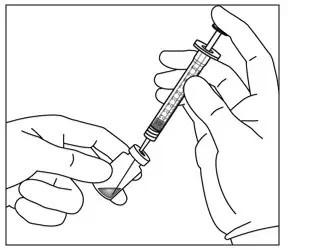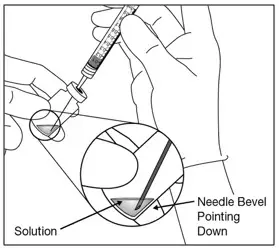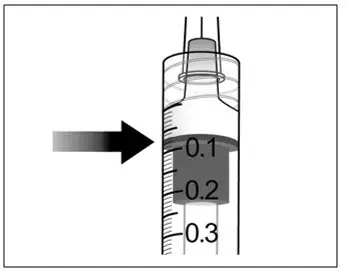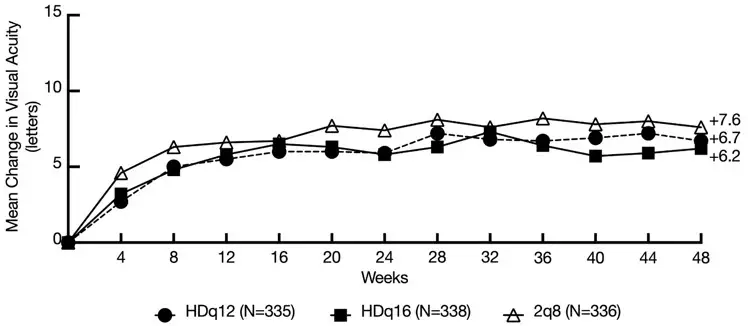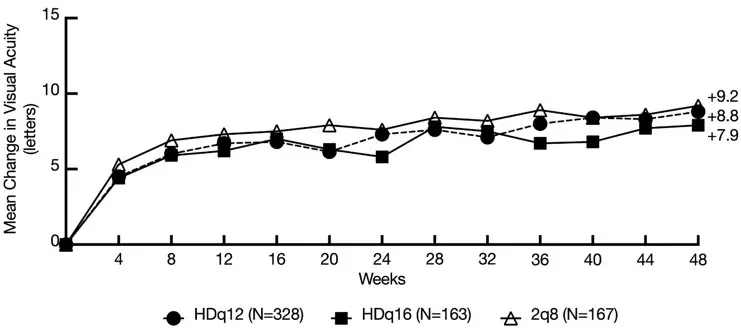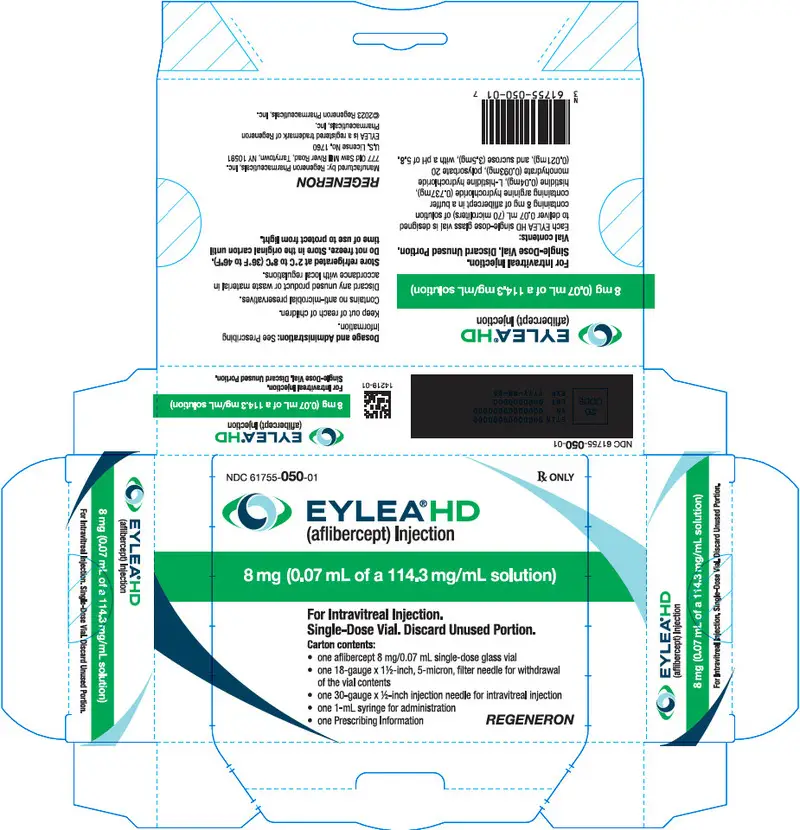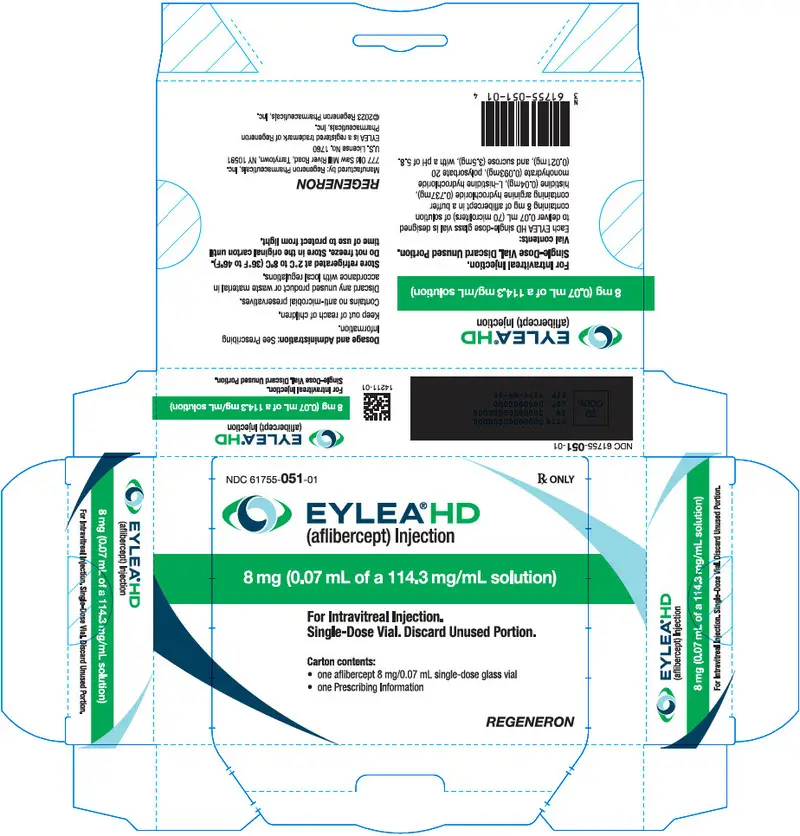Drug Detail:Eylea and eylea hd (Aflibercept ophthalmic)
Drug Class: Anti-angiogenic ophthalmic agents
Highlights of Prescribing Information
EYLEA® HD (aflibercept) injection, for intravitreal use
Initial U.S. Approval: 2011
Indications and Usage for Eylea HD
EYLEA HD is a vascular endothelial growth factor (VEGF) inhibitor indicated for the treatment of patients with:
- Neovascular (Wet) Age-Related Macular Degeneration (nAMD) (1.1)
- Diabetic Macular Edema (DME) (1.2)
- Diabetic Retinopathy (DR) (1.3)
Eylea HD Dosage and Administration
-
Neovascular (Wet) Age-Related Macular Degeneration (nAMD)
- The recommended dose for EYLEA HD is 8 mg (0.07 mL of 114.3 mg/mL solution) administered by intravitreal injection every 4 weeks (approximately every 28 days +/- 7 days) for the first three doses, followed by 8 mg (0.07 mL of 114.3 mg/mL solution) via intravitreal injection once every 8 to 16 weeks, +/- 1 week. (2.2)
-
Diabetic Macular Edema (DME)
- The recommended dose for EYLEA HD is 8 mg (0.07 mL of 114.3 mg/mL solution) administered by intravitreal injection every 4 weeks (approximately every 28 days +/- 7 days) for the first three doses, followed by 8 mg (0.07 mL of 114.3 mg/mL solution) via intravitreal injection once every 8 to 16 weeks, +/- 1 week. (2.3)
-
Diabetic Retinopathy (DR)
- The recommended dose for EYLEA HD is 8 mg (0.07 mL of 114.3 mg/mL solution) administered by intravitreal injection every 4 weeks (approximately every 28 days +/- 7 days) for the first three doses, followed by 8 mg (0.07 mL of 114.3 mg/mL solution) via intravitreal injection once every 8 to 12 weeks, +/- 1 week. (2.4)
Dosage Forms and Strengths
- Injection: 8 mg (0.07 mL of 114.3 mg/mL solution) in a single-dose vial (3)
Contraindications
- Ocular or periocular infection (4.1)
- Active intraocular inflammation (4.2)
- Hypersensitivity (4.3)
Warnings and Precautions
- Endophthalmitis and retinal detachments may occur following intravitreal injections. Patients should be instructed to report any symptoms suggestive of endophthalmitis or retinal detachment without delay and should be managed appropriately. (5.1)
- Increases in intraocular pressure have been seen within 60 minutes of an intravitreal injection. (5.2)
- There is a potential risk of arterial thromboembolic events following intravitreal use of VEGF inhibitors. (5.3)
Adverse Reactions/Side Effects
The most common adverse reactions (≥3%) reported in patients treated with EYLEA HD were cataract, conjunctival hemorrhage, intraocular pressure increased, ocular discomfort/eye pain/eye irritation, vision blurred, vitreous floaters, vitreous detachment, corneal epithelium defect, and retinal hemorrhage. (6.1)
To report SUSPECTED ADVERSE REACTIONS, contact Regeneron at 1-855-395-3248 or FDA at 1-800-FDA-1088 or www.fda.gov/medwatch.
See 17 for PATIENT COUNSELING INFORMATION.
Revised: 8/2023
Related/similar drugs
Vabysmo, dexamethasone ophthalmic, Eylea, Lucentis, fluocinolone ophthalmic, aflibercept ophthalmic, ranibizumab ophthalmicFull Prescribing Information
2. Eylea HD Dosage and Administration
2.1 Important Injection Instructions
For ophthalmic intravitreal injection. EYLEA HD must only be administered by a qualified physician.
A 5-micron sterile filter needle (18-gauge × 1½-inch), a 1-mL Luer lock syringe and a 30-gauge × ½-inch sterile injection needle are needed.
EYLEA HD is available packaged as follows:
- Vial Only
- Vial Kit with Injection Components (filter needle, syringe, injection needle)
[see How Supplied/Storage and Handling (16)].
2.2 Neovascular (Wet) Age-Related Macular Degeneration (nAMD)
The recommended dose for EYLEA HD is 8 mg (0.07 mL of 114.3 mg/mL solution) administered by intravitreal injection every 4 weeks (approximately every 28 days +/- 7 days) for the first three doses, followed by 8 mg (0.07 mL of 114.3 mg/mL solution) via intravitreal injection once every 8 to 16 weeks, +/- 1 week.
2.3 Diabetic Macular Edema (DME)
The recommended dose for EYLEA HD is 8 mg (0.07 mL of 114.3 mg/mL solution) administered by intravitreal injection every 4 weeks (approximately every 28 days +/- 7 days) for the first three doses, followed by 8 mg (0.07 mL of 114.3 mg/mL solution) via intravitreal injection once every 8 to 16 weeks, +/- 1 week.
2.4 Diabetic Retinopathy (DR)
The recommended dose for EYLEA HD is 8 mg (0.07 mL of 114.3 mg/mL solution) administered by intravitreal injection every 4 weeks (approximately every 28 days +/- 7 days) for the first three doses, followed by 8 mg (0.07 mL of 114.3 mg/mL solution) via intravitreal injection once every 8 to 12 weeks, +/- 1 week.
2.5 Preparation for Administration
The EYLEA HD glass vial is for one-time use in one eye only. Discard unused portion. EYLEA HD does not contain an anti-microbial preservative. Extraction of multiple doses from a single vial may increase the risk of contamination and subsequent infection.
Do not use if the package or its components are expired, damaged, or have been tampered with.
Check the label on the vial to make sure you have the correct aflibercept strength.
Prepare for intravitreal injection with the following medical devices for single use.
- a 5-micron sterile filter needle (18-gauge × 1½-inch)
- a 1-mL sterile Luer lock syringe (with marking to measure 0.07 mL)
- a sterile injection needle (30-gauge × ½-inch)
- 1.
- Parenteral drug products should be inspected visually for particulate matter and discoloration prior to administration, whenever solution and container permit. Do not use the vial if particulates, cloudiness, or discoloration are visible.
- 2.
- Remove the protective plastic cap from the vial (see Figure 1).
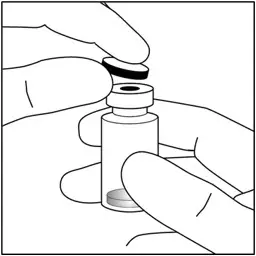
- 3.
- Clean the top of the vial with an alcohol wipe (see Figure 2).

- 4.
- Use aseptic technique to carry out steps 4 – 11. Remove the 18-gauge × 1½-inch, 5-micron, filter needle and the 1-mL syringe from their packaging. Attach the filter needle to the syringe by twisting it onto the Luer lock syringe tip (see Figure 3).

- 5.
- Push the filter needle into the center of the vial stopper until the needle is completely inserted into the vial and the tip touches the bottom or bottom edge of the vial.
- 6.
- Withdraw all of the EYLEA HD vial contents into the syringe, keeping the vial in an upright position, slightly inclined to ease complete withdrawal. To deter the introduction of air, ensure the bevel of the filter needle is submerged into the liquid. Continue to tilt the vial during withdrawal keeping the bevel of the filter needle submerged in the liquid (see Figure 4a and Figure 4b).
- 7.
- Ensure that the plunger rod is drawn sufficiently back when emptying the vial in order to completely empty the filter needle.
- 8.
- Remove the filter needle from the syringe and properly dispose of the filter needle. Note: Filter needle is not to be used for intravitreal injection.
- 9.
- Remove the 30-gauge × ½-inch injection needle from its packaging and attach the injection needle to the syringe by firmly twisting the injection needle onto the Luer lock syringe tip (see Figure 5).

- 10.
- Holding the syringe with the needle pointing up, check the syringe for bubbles. If there are bubbles, gently tap the syringe with your finger until the bubbles rise to the top (see Figure 6).
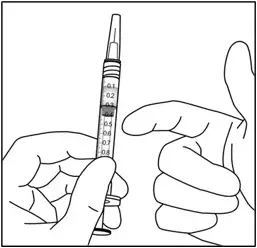
- 11.
- To eliminate all of the bubbles and to expel excess drug, SLOWLY depress the plunger so that the plunger tip aligns with the line that marks 0.07 mL on the syringe (see Figure 7a and Figure 7b).
2.6 Injection Procedure
The intravitreal injection procedure should be carried out under controlled aseptic conditions, which include surgical hand disinfection and the use of sterile gloves, a sterile drape, and a sterile eyelid speculum (or equivalent). Adequate anesthesia and a topical broad–spectrum microbicide should be given prior to the injection.
Immediately following the intravitreal injection, patients should be monitored for elevation in intraocular pressure. Appropriate monitoring may consist of a check for perfusion of the optic nerve head or tonometry. If required, a sterile paracentesis needle should be available.
Following intravitreal injection, patients and/or caregivers should be instructed to report any signs and/or symptoms suggestive of endophthalmitis or retinal detachment (e.g., eye pain, redness of the eye, photophobia, blurring of vision) without delay [see Patient Counseling Information (17)].
Each vial should only be used for the treatment of a single eye. If the contralateral eye requires treatment, a new vial should be used and the sterile field (including a new syringe, gloves, drapes, eyelid speculum, filter and injection needles) should be changed before EYLEA HD is administered to the other eye.
After injection, discard any unused product or waste material in accordance with local regulations.
3. Dosage Forms and Strengths
EYLEA HD is a clear to slightly opalescent, colorless to pale yellow solution available as:
- Injection: 8 mg (0.07 mL of a 114.3 mg/mL solution) in a single-dose glass vial
4. Contraindications
4.1 Ocular or Periocular Infections
EYLEA HD is contraindicated in patients with ocular or periocular infections.
5. Warnings and Precautions
5.1 Endophthalmitis and Retinal Detachments
Intravitreal injections including those with aflibercept have been associated with endophthalmitis and retinal detachments [see Adverse Reactions (6.1)]. Proper aseptic injection technique must always be used when administering EYLEA HD. Patients and/or caregivers should be instructed to report any signs and/or symptoms suggestive of endophthalmitis or retinal detachment without delay and should be managed appropriately [see Dosage and Administration (2.6) and Patient Counseling Information (17)].
5.2 Increase in Intraocular Pressure
Acute increases in intraocular pressure have been seen within 60 minutes of intravitreal injection, including with EYLEA HD [see Adverse Reactions (6.1)]. Sustained increases in intraocular pressure have also been reported after repeated intravitreal dosing with vascular endothelial growth factor (VEGF) inhibitors. Intraocular pressure and the perfusion of the optic nerve head should be monitored and managed appropriately [see Dosage and Administration (2.6)].
5.3 Thromboembolic Events
There is a potential risk of arterial thromboembolic events (ATEs) following intravitreal use of VEGF inhibitors, including EYLEA HD. ATEs are defined as nonfatal stroke, nonfatal myocardial infarction, or vascular death (including deaths of unknown cause). The incidence of reported thromboembolic events in the wet AMD study (PULSAR) from baseline through week 48 was 0.4% (3 out of 673) in the combined group of patients treated with EYLEA HD compared with 1.5% (5 out of 336) in patients treated with EYLEA 2 mg. The incidence of reported thromboembolic events in the DME study (PHOTON) from baseline to week 48 was 3.1% (15 out of 491) in the combined group of patients treated with EYLEA HD compared with 3.6% (6 out of 167) in patients treated with EYLEA 2 mg.
6. Adverse Reactions/Side Effects
The following potentially serious adverse reactions are described elsewhere in the labeling:
- Hypersensitivity [see Contraindications (4.3)]
- Endophthalmitis and retinal detachments [see Warnings and Precautions (5.1)]
- Increase in intraocular pressure [see Warnings and Precautions (5.2)]
- Thromboembolic events [see Warnings and Precautions (5.3)]
6.1 Clinical Trials Experience
Because clinical trials are conducted under widely varying conditions, adverse reaction rates observed in the clinical trials of a drug cannot be directly compared to rates in other clinical trials of the same or another drug and may not reflect the rates observed in practice.
A total of 1164 patients were treated with EYLEA HD and 503 patients were treated with EYLEA 2 mg in two clinical studies. The most common adverse reactions reported in ≥3% of patients treated with EYLEA HD were cataract, conjunctival hemorrhage, intraocular pressure increased, ocular discomfort/eye pain/eye irritation, vision blurred, vitreous floaters, vitreous detachment, corneal epithelium defect, and retinal hemorrhage. The data described below reflect exposure to EYLEA HD or EYLEA 2 mg in controlled clinical studies (PULSAR and PHOTON), each for 48 weeks [see Clinical Studies (14.1, 14.2)].
| Adverse Reactions | PULSAR | PHOTON | ||||||||||||||
|---|---|---|---|---|---|---|---|---|---|---|---|---|---|---|---|---|
| EYLEA HD q12 | EYLEA HD q16 | EYLEA 2q8 | EYLEA HD q12 | EYLEA HD q16 | EYLEA 2q8 | |||||||||||
| n=335 | n=338 | n=336 | n=328 | n=163 | n=167 | |||||||||||
|
||||||||||||||||
| Cataract* | 4% | 4% | 4% | 3% | 6% | 3% | ||||||||||
| Conjunctival hemorrhage* | 3% | 2% | 1% | 4% | 4% | 4% | ||||||||||
| Intraocular pressure increased* | 4% | 4% | 2% | 3% | 1% | 4% | ||||||||||
| Ocular discomfort/eye pain/eye irritation* | 3% | 3% | 2% | 4% | 2% | 4% | ||||||||||
| Vision blurred* | 4% | 6% | 7% | 3% | 3% | 4% | ||||||||||
| Vitreous floaters* | 1% | 4% | 3% | 5% | 2% | 3% | ||||||||||
| Vitreous detachment* | 2% | 3% | 2% | 4% | 2% | 1% | ||||||||||
| Corneal epithelium defect* | 2% | 2% | 3% | 3% | 6% | 1% | ||||||||||
| Retinal hemorrhage | 3% | 3% | 4% | 0 | 4% | 1% | ||||||||||
| Intraocular inflammation* | 1% | 1% | 1% | 1% | 0 | 1% | ||||||||||
| Retinal pigment epithelial tear/epitheliopathy* | 2% | 1% | 2% | <1% | 0 | 0 | ||||||||||
| Vitreous hemorrhage | <1% | 1% | 1% | 2% | 1% | 1% | ||||||||||
| Retinal Detachment* | 1% | <1% | 0 | <1% | 1% | 0 | ||||||||||
| Foreign body sensation in eyes* | 1% | 1% | 2% | <1% | 0 | 0 | ||||||||||
| Retinal pigment epithelial detachment* | 1% | 1% | 2% | 0 | 0 | 0 | ||||||||||
Adverse drug reactions (ADRs) reported in <1% of participants treated with EYLEA HD were ocular hyperemia (includes adverse events of conjunctival hyperemia, conjunctival irritation, ocular hyperemia), lacrimation increased, eyelid edema, hypersensitivity (includes adverse events of rash, urticaria, pruritus), retinal tear and injection site hemorrhage.
8. Use In Specific Populations
8.1 Pregnancy
Data
Animal Data
In two embryofetal development studies, aflibercept produced adverse embryofetal effects when administered every three days during organogenesis to pregnant rabbits at intravenous doses ≥3 mg per kg, or every six days during organogenesis at subcutaneous doses ≥0.1 mg per kg.
Adverse embryofetal effects included increased incidences of postimplantation loss and fetal malformations, including anasarca, umbilical hernia, diaphragmatic hernia, gastroschisis, cleft palate, ectrodactyly, intestinal atresia, spina bifida, encephalomeningocele, heart and major vessel defects, and skeletal malformations (fused vertebrae, sternebrae, and ribs; supernumerary vertebral arches and ribs; and incomplete ossification). The maternal No Observed Adverse Effect Level (NOAEL) in these studies was 3 mg per kg. Aflibercept produced fetal malformations at all doses assessed in rabbits and the fetal NOAEL was not identified. At the lowest dose shown to produce adverse embryofetal effects in rabbits (0.1 mg per kg), systemic exposure (AUC) of free aflibercept was approximately 0.9-fold of the population pharmacokinetic estimated systemic exposure (AUC) in humans after an intravitreal dose of 8 mg.
8.4 Pediatric Use
The safety and effectiveness of EYLEA HD in pediatric patients have not been established.
8.5 Geriatric Use
In PULSAR, approximately 90% (604/673) of the patients in the HDq12 and HDq16 groups were 65 years of age or older and approximately 51% (343/673) were 75 years of age or older.
In PHOTON, approximately 44% (214/491) of the patients in the HDq12 and HDq16 groups were 65 years of age or older and approximately 10% (50/491) were 75 years of age or older.
10. Overdosage
Overdosing with increased injection volume may increase intraocular pressure. Therefore, in case of overdosage, intraocular pressure should be monitored and if deemed necessary by the treating physician, adequate treatment should be initiated.
11. Eylea HD Description
Aflibercept is a recombinant fusion protein consisting of portions of human VEGF receptors 1 and 2 extracellular domains fused to the Fc portion of human IgG1 formulated as an iso-osmotic solution for intravitreal administration. Aflibercept is a dimeric glycoprotein and contains glycosylation, constituting an additional 15% of the total molecular mass, resulting in a total molecular weight of 115 kDa. Aflibercept is produced in recombinant Chinese hamster ovary (CHO) cells.
EYLEA HD (aflibercept) injection is a sterile, clear to slightly opalescent, and colorless to pale yellow solution. EYLEA HD is supplied as a sterile, aqueous solution for intravitreal injection in a single-dose glass vial designed to deliver 0.07 mL (70 microliters) of solution containing 8 mg of aflibercept in a buffer containing arginine hydrochloride (0.737 mg), histidine (0.04 mg), L-histidine hydrochloride monohydrate (0.093 mg), polysorbate 20 (0.021 mg), sucrose (3.5 mg) and water for injection with a pH of 5.8. EYLEA HD does not contain an anti-microbial preservative.
12. Eylea HD - Clinical Pharmacology
12.1 Mechanism of Action
Vascular endothelial growth factor-A (VEGF-A) and placental growth factor (PlGF) are members of the VEGF family of angiogenic factors that can act as mitogenic, chemotactic, and vascular permeability factors for endothelial cells. VEGF acts via two receptor tyrosine kinases, VEGFR-1 and VEGFR-2, present on the surface of endothelial cells. PlGF binds only to VEGFR-1, which is also present on the surface of leucocytes. Activation of these receptors by VEGF-A can result in neovascularization and vascular permeability.
Aflibercept acts as a soluble decoy receptor that binds VEGF-A and PlGF, and thereby can inhibit the binding and activation of these cognate VEGF receptors.
12.2 Pharmacodynamics
Increased retinal thickness, assessed by optical coherence tomography (OCT), is associated with nAMD and DME. Reductions in central subfield thickness (CST) were observed across all treatment arms throughout the two Phase 3 studies in nAMD and DME.
12.3 Pharmacokinetics
EYLEA HD is administered intravitreally to exert local effects in the eye. In patients with wet AMD, or DME, following intravitreal administration of EYLEA HD, a fraction of the administered dose is expected to bind with endogenous VEGF in the eye to form an inactive aflibercept: VEGF complex. Once absorbed into the systemic circulation, aflibercept presents in the plasma as free aflibercept (unbound to VEGF) and a more predominant stable inactive form with circulating endogenous VEGF (i.e., aflibercept: VEGF complex).
12.6 Immunogenicity
The observed incidence of anti-drug antibodies is highly dependent on the sensitivity and specificity of the assay. Differences in assay methods preclude meaningful comparisons of the incidence of anti-drug antibodies in the studies described below with the incidence of anti-drug antibodies for other products.
During the 48-week treatment with aflibercept administrated IVT, the incidence of anti-aflibercept antibody formation in the 8 mg treatment groups was 2.7% (25/937 participants with nAMD [PULSAR] or DME [PHOTON]).
13. Nonclinical Toxicology
13.1 Carcinogenesis, Mutagenesis, Impairment of Fertility
No studies have been conducted on the mutagenic or carcinogenic potential of aflibercept. Effects on male and female fertility were assessed as part of a 6-month study in monkeys with intravenous administration of aflibercept at weekly doses ranging from 3 to 30 mg per kg. Absent or irregular menses associated with alterations in female reproductive hormone levels and changes in sperm morphology and motility were observed at all dose levels. In addition, females showed decreased ovarian and uterine weight accompanied by compromised luteal development and reduction of maturing follicles. These changes correlated with uterine and vaginal atrophy. All changes were reversible within 20 weeks after cessation of treatment. A No Observed Adverse Effect Level (NOAEL) was not identified. Intravenous administration of the lowest dose of aflibercept assessed in monkeys (3 mg per kg) resulted in systemic exposure (AUC) for free aflibercept that was 91 times higher than the population pharmacokinetic estimated systemic exposure in humans after an intravitreal dose of 8 mg.
13.2 Animal Toxicology and/or Pharmacology
Erosions and ulcerations of the respiratory epithelium in nasal turbinates in monkeys treated with aflibercept intravitreally were observed at intravitreal doses of 2, 4 or 7 mg per eye. At the NOAEL of 0.5 mg per eye in monkeys, the systemic exposure (AUC) for free aflibercept was approximately 3 times higher than the population pharmacokinetic estimated exposure observed in humans after an intravitreal dose of 8 mg. Similar effects were not seen in clinical studies [see Clinical Studies (14)].
14. Clinical Studies
14.1 Neovascular (Wet) Age-Related Macular Degeneration (nAMD)
The safety and efficacy of EYLEA HD were assessed in a randomized, multi-center, double-masked, active-controlled study (PULSAR) in treatment-naïve patients with nAMD. A total of 1009 patients were treated and analyzed for efficacy (673 with EYLEA HD). Patients were randomly assigned in a 1:1:1 ratio to 1 of 3 treatment groups: 1) EYLEA HD administered every 12 weeks following 3 initial monthly doses (HDq12); 2) EYLEA HD administered every 16 weeks following 3 initial monthly doses (HDq16); 3) EYLEA 2 mg administered every 8 weeks (2q8) following 3 initial monthly doses. In the EYLEA HD groups, patients could be treated as frequently as every 8 weeks based on protocol-defined visual and anatomic criteria, starting at week 16. Patients ranged from 50 to 96 years of age with a mean of 74.5 years. At baseline, mean visual acuity was approximately 60 letters (range: 24 to 78 letters).
The primary efficacy endpoint was the change from baseline in BCVA at week 48 as measured by the Early Treatment Diabetic Retinopathy Study (ETDRS) letter score.
Both HDq12 and HDq16 treatments were shown to be non-inferior and clinically equivalent to 2q8 treatment with respect to the change in BCVA score at week 48 using the pre-specified non-inferiority margin of 4 letters. In patients completing week 48, the mean number of injections administered were 5.2 in the HDq16 group (n=312), 6.1 in the HDq12 group (n=316) and 6.9 in the EYLEA q8 group (n=309). Detailed results from the analysis of the PULSAR study are shown in Table 2 and Figure 8 below.
Efficacy results in all subgroups (e.g., age, gender, geographic region, ethnicity, race, baseline BCVA and lesion type) were consistent with those in the overall population.
| Efficacy Outcomes | EYLEA HDq12 | EYLEA HDq16 | EYLEA 2q8 |
|---|---|---|---|
| BCVA = Best Corrected Visual Acuity; ETDRS = Early Treatment Diabetic Retinopathy Study; SD = Standard Deviation; LS = Least Square; SE = Standard Error; CI = Confidence Interval; MMRM = Mixed Model for Repeated Measurements | |||
|
|||
| Full Analysis Set* | N=335 | N=338 | N=336 |
| Mean change in BCVA as measured by ETDRS letter score from baseline (SD) at week 48† | 6.7 (12.6) | 6.2 (11.7) | 7.6 (12.2) |
| LS mean (SE) change from baseline ‡ | 6.1 (0.8) | 5.9 (0.7) | 7.0 (0.7) |
| Difference in LS mean (95% CI)‡ | -1.0 (-2.9, 0.9) | -1.1 (-3.0, 0.7) | |
Figure 8: Mean Change from Baseline in BCVA as measured by ETDRS Letter Score by Visits through Week 48 (Observed Cases)
14.2 Diabetic Macular Edema (DME)
The safety and efficacy of EYLEA HD was assessed in a randomized, multi-center, double-masked, active-controlled study (PHOTON) in patients with DME involving the center of the macula. A total of 658 patients were treated and analyzed for efficacy (491 with EYLEA HD). Patients were randomly assigned in a 2:1:1 ratio to 1 of 3 treatment groups: 1) EYLEA HD administered every 12 weeks following 3 initial monthly doses (HDq12); 2) EYLEA HD administered every 16 weeks following 3 initial monthly doses (HDq16); 3) EYLEA 2 mg administered every 8 weeks (2q8) following 5 initial monthly doses. In the EYLEA HD groups, patients could be treated as frequently as every 8 weeks based on protocol-defined visual and anatomic criteria, starting at week 16. Patient ages ranged from 24 to 90 years with a mean of 62.3 years. A total of 44% of patients were previously treated for DME. At baseline, the overall mean visual acuity was 63 letters (range: 24 to 79 letters).
The primary efficacy endpoint was the change from baseline in BCVA at week 48 as measured by the ETDRS letter score. Both HDq12 and HDq16 treatments were shown to be non-inferior and clinically equivalent to 2q8 treatment with respect to the change in BCVA score at week 48 using the pre-specified non-inferiority margin of 4 letters. In patients completing week 48, the mean number of injections administered were 5.0 in the HDq16 group (n=155), 6.0 in the HDq12 group (n=298) and 7.9 in the EYLEA q8 group (n=156). Detailed results from the analysis of the PHOTON study are shown in Table 3 and Figure 9 below.
| Efficacy Outcomes | EYLEA HDq12 | EYLEA HDq16 | EYLEA 2q8 |
|---|---|---|---|
| BCVA = Best Corrected Visual Acuity; ETDRS = Early Treatment Diabetic Retinopathy Study; SD = Standard Deviation; LS = Least Square; SE = Standard Error; CI = Confidence Interval; MMRM = Mixed Model for Repeated Measurements. | |||
|
|||
| Full Analysis Set* | N=328 | N=163 | N=167 |
| Mean change in BCVA as measured by ETDRS letter score from baseline (SD) at week 48† | 8.8 (9.0) | 7.9 (8.4) | 9.2 (9.0) |
| LS mean (SE) change from baseline‡ | 8.1 (0.6) | 7.2 (0.7) | 8.7 (0.7) |
| Difference in LS mean (95% CI)‡ | -0.6 (-2.3, 1.1) | -1.4 (-3.3, 0.4) | |
Efficacy results in all subgroups (e.g., age, gender, geographic region, ethnicity, race, baseline, BCVA, baseline CRT and prior DME treatment) were consistent with those in the overall population.
Figure 9: Mean Change from Baseline in BCVA as measured by ETDRS Letter Score by Visits through Week 48 (Observed Cases)
14.3 Diabetic Retinopathy (DR)
Efficacy and safety data of EYLEA HD in diabetic retinopathy (DR) are derived from the PHOTON study.
In the PHOTON study, a key efficacy outcome was the change in the Early Treatment Diabetic Retinopathy Study (ETDRS) Diabetic Retinopathy Severity Scale (ETDRS-DRSS). Each EYLEA HD group was compared to the 2q8 group using a NI margin of 10%.
The ETDRS-DRSS score was assessed at baseline and approximately every 3 months thereafter for the duration of the study [see Clinical Studies (14.2)]. Baseline ETDRS-DRSS scores were generally balanced across treatment groups.
Results from the analysis of ETDRS-DRSS scores at week 48 in the PHOTON study are shown in Table 4 below:
| Efficacy Outcomes | EYLEA HDq12 | EYLEA HDq16 | EYLEA 2q8 |
|---|---|---|---|
| Missing or non-gradable post-baseline ETDRS-DRSS values were imputed using the last gradable ETDRS-DRSS values. Patients were considered as non-responders if all post-baseline measurements were missing or non-gradable. Missing or ungradable baseline was not included in the denominator. | |||
|
|||
| Full Analysis Set* | N=328 | N=163 | N=167 |
| Proportion of patients with a ≥2-step improvement on ETDRS-DRSS from Baseline (%)† | 29% | 20% | 27% |
| Difference‡(%) (95% CI) | 2% (-6.6, 10.6) | -8% (-16.9, 1.8) | |
The EYLEA HDq16 did not meet the non-inferiority criteria for the proportion of patients with a ≥2-step improvement on ETDRS-DRSS and is not considered clinically equivalent to EYLEA administered every 8 weeks.
Results of the subgroups (e.g., age, gender, race, ethnicity, baseline BCVA and prior DME treatment) on the proportion of patients who achieved a ≥2-step improvement on the ETDRS-DRSS from baseline to week 48 were, in general, consistent with those in the overall population.
16. How is Eylea HD supplied
16.1 How Supplied
EYLEA HD (aflibercept) is a clear to slightly opalescent, colorless to pale yellow solution supplied in the following presentations [see Dosage and Administration (2.5) and (2.6)]. Each vial is for single eye use only. Discard unused portion.
| NDC NUMBER | CARTON TYPE | CARTON CONTENTS |
|---|---|---|
| 61755-050-01 | Vial Kit with Injection Components |
|
| 61755-051-01 | Vial Only |
|
17. Patient Counseling Information
In the days following EYLEA HD administration, patients are at risk of developing endophthalmitis or retinal detachment. If the eye becomes red, sensitive to light, painful, or develops a change in vision, advise patients and/or caregivers to seek immediate care from an ophthalmologist [see Warnings and Precautions (5.1)].
Patients may experience temporary visual disturbances after an intravitreal injection with EYLEA HD and the associated eye examinations [see Adverse Reactions (6)]. Advise patients not to drive or use machinery until visual function has recovered sufficiently.
| EYLEA HD
aflibercept injection, solution |
||||||||||||||||||||||||||||||
|
||||||||||||||||||||||||||||||
|
||||||||||||||||||||||||||||||
|
||||||||||||||||||||||||||||||
|
||||||||||||||||||||||||||||||
|
||||||||||||||||||||||||||||||
| EYLEA HD
aflibercept injection, solution |
||||||||||||||||||||||||||||||
|
||||||||||||||||||||||||||||||
|
||||||||||||||||||||||||||||||
|
||||||||||||||||||||||||||||||
|
||||||||||||||||||||||||||||||
|
||||||||||||||||||||||||||||||
| Labeler - Regeneron Pharmaceuticals, Inc (194873139) |
| Establishment | |||
| Name | Address | ID/FEI | Business Operations |
|---|---|---|---|
| Regeneron Pharmaceuticals, Inc | 945589711 | API MANUFACTURE(61755-050, 61755-051) , ANALYSIS(61755-050, 61755-051) , LABEL(61755-050, 61755-051) , MANUFACTURE(61755-050, 61755-051) | |




